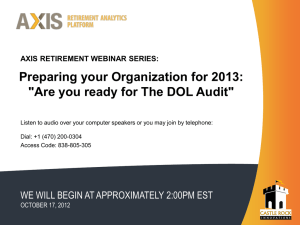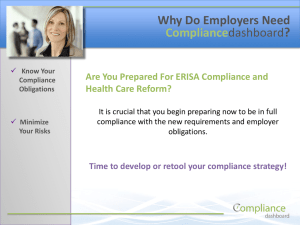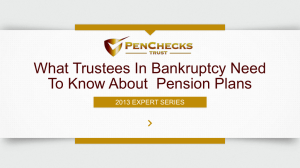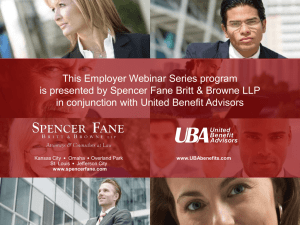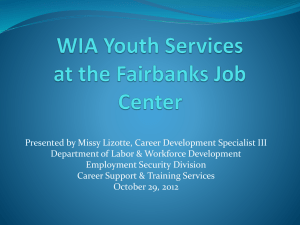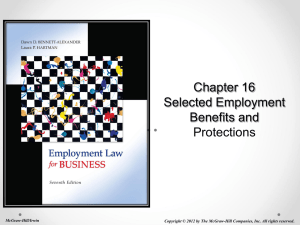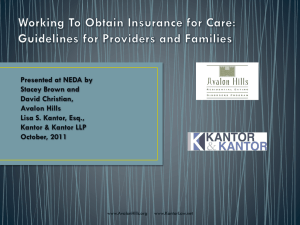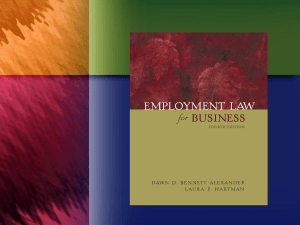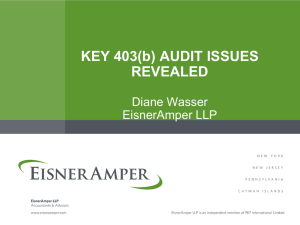Compliance Seminar: Surving an Audit
advertisement
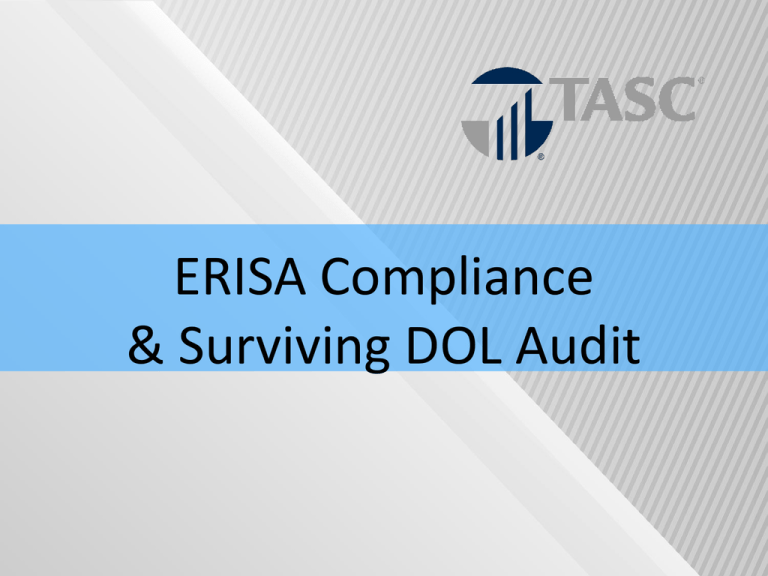
ERISA Compliance & Surviving DOL Audit TASC Confidentiality • This Seminar and all materials presented are the property of TASC. No part of this seminar or any of the materials provided may be reproduced or transmitted in any form or by any means, electronic, mechanical, photocopying, recording, or otherwise, without prior written permission from TASC. To the extent allowed by law, TASC intends to recoup any value lost by an unauthorized use or disclosure including the TASC profits that may have been lost or the profits made by the disclosing party. • IRS Circular 230 disclosure: To ensure compliance with requirements imposed by the IRS, we inform you that if any advice concerning one or more U.S. Federal tax issues is contained in this seminar material or is provided by a speaker at the seminar, such advice is not intended or written to be used, and cannot be used, for the purpose of (i) avoiding penalties under the Internal Revenue Code; or (ii) promoting, marketing, or recommending to another party any transaction or matter addressed herein, and you should seek advice based on your particular circumstances from an independent tax advisor. TASC • National TPA for Employee Benefits • Established in 1975 • Serving Mid-Large Market – Fortune 500 – Private and Public – State, county, and city government • Headquarters in Madison, WI • Over 700 Employees Nationwide 700 Employees National Presence 60 Offices 45 Regional Sales Directors (150 by 2016) 10,000 Broker/Distributors 55,700 Clients 750,000+ Participants ERISAEdge Experience Carolyn McNairy- Sales Development Director of Compliance Services •Carolyn is Sales Development Director of Compliance Services) for Total Administrative Services Corporation (TASC) where she also served as the Product Administrator for ERISAEdge. •Her role also includes conducting National Seminars and Webinars to educate the TASC Group Sales Force, •Employee Benefit Consultants, General Agents, Insurance Carrier Sales Staff and Providers and clients on ERISA/FMLA/COBRA/FSA legal requirements. She has conducted over 2000 National Seminars and conducts monthly Provider and client Webinars. •Carolyn has been in the employee benefit and administration business since 1978. She is the President and founder of C&J Consulting & Administration, Inc., a company specializing in compliance issues and administration of ERISA. She agency was purchased by TASC in February of 2008. Rick Jones-Esq. Staff Attorney ● ● ● ● Rick Jones was the Vice President of COBRA Services and the Staff Attorney at HFS Benefits for 10 years. HFS was purchased by TASC on July 1, 2011. Rick is currently the Staff Attorney for Total Administrative Services Corporation (“TASC”). HFS Benefits and TASC provide Section 125 (Cafeteria Plan), HRA, HSA, Transportation and COBRA Administration services to employers nationwide, including discrimination testing and 5500 filings. In his current role, Mr. Jones advises TASC on product compliance, contractual issues with clients, and any compliance issues that arise. Rick has been in Employee Benefits business since 1989. Jeb Hennessey- Vice President – Compliance ● Jeb manages a staff responsible for the generation and delivery of ERISA welfare benefit wrap plan documents/Summary Plan Descriptions, welfare Form 5500 returns (including DFVCP filings), Summary Annual Reports., Cafeteria and welfare benefit plan nondiscrimination testing including the testing of cafeteria plans, Flexible Spending Accounts, Health Reimbursement Arrangements, self-insured medical plans and group term life insurance plans. ● HFS was purchased by TASC on July 1, 2011. Jeb was with HFS from 2003 to until purchase. ● Jeb has been in Employee Benefits Administration since 1992. What’s the origin of ERISA? • Location: Studebaker Corporation in South Bend, Indiana. • Date: December 23, 1963 • Event: The company has announced the plant is closing…. Sources: DiFelice v. Aetna U.S. Healthcare, 346 F.3d 442, 454 (3d Cir., 2003) "The Most Glorious Story of Failure in the Business: The Studebaker-Packard Corporation and the Origins of ERISA" by James A. Wooten What’s the origin of ERISA? … what happened next wasn’t so pretty • 5,000 workers dismissed • Pension plan terminated that covered 11,000 members of United Automobile Workers • Underfunded plan: not enough funds to cover vested benefits • Of the 11,000 workers: 4,100 reaching age 60 received a full pension 4,000 (59.5 years old, 43 years of service) received 15% 2,900 received nothing at all Some with 40+ years of service missed full pension (age 60) by a few months And, just days before December holidays, 3,000 laid off with no pension Source: "The Most Glorious Story of Failure in the Business: The StudebakerPackard Corporation and the Origins of ERISA" by James A. Wooten ERISA: Employee Retirement Income Security Act • ERISA is governed by the U.S Department of Labor and enforced by the Employee Benefits Security Administration (EBSA). • The EBSA’s primary responsibility is to ensure the integrity and compliance of the private employee benefits plan system in the United States. • EBSA Mission Statement – The mission of the Employee Benefits Security Administration is to assure the security of the retirement, health and other workplace related benefits of America's workers and their families. We will accomplish this mission by developing effective regulations; assisting and educating workers, Plan Sponsors, fiduciaries and service providers; and vigorously enforcing the law. http://www.dol.gov/ebsa/ erisa_enforcement.html Why are so many Employers out of Compliance? • • • • Overall Lack of Awareness in Marketplace Carrier Documents thought to be Compliant Confusion due to a Complexity of the Regulations Prior Limited Enforcement • However, Compliance is “Not An Option”…It’s the Law! – Statistics are that 90-95% of Employers have at least one violation of ERISA regulations. ERISA Defined • Employee Retirement Income Security Act (ERISA) – Federal Law Enacted in 1974 – Title 1 is part of U.S. labor laws; governs the structure of employee benefits plans. • Requires detailed disclosure to covered individuals. (Applies to all Private Sector Employers regardless of size) • Requires detailed reporting to the government. )(Plans with 100+ participants) • Imposes strict fiduciary code of conduct on those who sponsor and administer ERISA Plans. • Imposes federal mechanism for enforcing rights and duties with respect to ERISA Plans and preempts a large body of state laws. ERISA Defined (cont’d.) • DOL (Department of Labor) – Failure to comply with ERISA’s requirements can be quite costly • Through DOL enforcement actions – Government Penalties for Non-Compliance » Case Law: 1) $86,500 – Failure to File Complete and Accurate Form 5500 Airport Hospitality, LTD, King of Prussia, Penn., 2010 2) $241,000 – Failure to Provide SPD to Participant Gorini v. AMP Inc., 117 Fed. Appex, 193 (3d Cir. 2004) 3) $10,780 - Failure to Provide SPD to Participant Kasireddy v. Bank of America Corp. Benefits Committee, 2010 WL 4168512 (N.D. Ill. Oct. 13, 2010) 4) $13,750 - Failure to Provide SPD to Participant Latimer v. Wash. Gas Light Co., 2012 WL 2119254 (E.D. Va. 2012) ERISA Titles • “Title 1” Applies to H&W benefits • 7 Parts (5 parts apply to H&W benefits) – – – – Part 1: Reporting & Disclosure Part 4: Fiduciary responsibility Part 5: Administration & Enforcement Part 6: COBRA and additional standards for group health plans – Part 7: HIPAA, Newborn & Mothers Health Protection, Mental Health Parity Act, Womens’ Health and Cancer Rights Act (WHCRA) What are the elements of an ERISA plan? Five elements of a “plan:” • plan/fund or program • established or maintained • by an employer or employee organization or both • for the purpose of providing welfare or retirement benefits • to participants and beneficiaries Source: ERISA Section 3(1). See also 29 C.F.R. Sections 2510.3-1, 2510.3-1(a)(2)) Welfare Benefit Plan • Examples: – – – – – – – – – Health, Dental and/or Vision Insurance or plans Health Flexible Spending Accounts (FSAs) Health Reimbursement Arrangements (HRAs) Accidental Death & Dismemberment Insurance Group Term Life Insurance Short- and Long-Term Disability Severance Insurance Wellness and Employee Assistance Programs Voluntary Benefits offered as pre-tax benefits under any Section Sources: ● ERISA Section 3 ● 29 C.F.R. Section 2510.3-1 Voluntary Insurance The DOL regulations state that insurance benefit programs offered by an insurer on a voluntary basis (100% employee paid) will not be deemed established or maintained by an employer, if the following four tests are met: (1) the employer makes no contributions, (2) participation is completely voluntary, (3) the sole function of the employer is, without endorsing the plan, permitting the insurer to publicize the program and collecting premiums through payroll deductions, and (4) the employer receives no commissions other than reasonable compensation for administrative services. Most voluntary programs can easily satisfy requirements # 1, 2, and 4. It is less clear what employer activities under #3 will cause a plan to fall outside the safe harbor and, thus, be subject to ERISA. Source: ● 29 C.F.R. Section 2510.3-1(j) Voluntary Insurance: Factors that impact the likelihood that an employer is endorsing an ERISA plan Pays premiums or reimburses employees for paid premium; or Offers a benefits program under a flexible benefit or cafeteria plan. likely Chooses insurers; Endorses the plan and permits the employer’s logo to be used by the insurer; Suggests or negotiates policy design, terms and rates; or Runs enrollment meetings. Reviews and approves literature distributed to its employees; Limits the number of insurers or products for administrative purposes; Prepares claim forms for employees; Allows its name to be used on insurer’s marketing materials; Answers employee questions about policy; Permits enrollment meetings during business hours; or Distributes certificates, enrollment forms and waiver cards. Permits employees to receive a group discount on individual policies; Permits employees to receive group rates on group policies; Serves as policyholder; Permits the insurer to advertise its policy and distribute information about the policy to employees; or Deducts and remits employee premiums at its employees’ direction. unlikely Employers Subject to ERISA • Private-Sector Employers – – – – Corporations Partnerships Sole Proprietorships Non-Profit Organizations • Unless Exempt under 501a as Governmental entity – (listing the following nine factors applied by the courts and the DOL in determining whether the governmental plan exception applies: whether (a) the state or local government exercised control over the plan; (b) the plan provides for only employer or employee contributions or for both; (c) government employees acted as fiduciaries under the plan; (d) the state or local government created the entity; (e) the entity is “administered by individuals who are responsible to public officials or to the general electorate”; (f) the state or local government exercises authority over the entity; (g) the entity performs traditional government functions; (h) the entity's employees are considered government employees under federal and state employment laws; and (i) the entity is funded by state or local government taxes or bonds. Safe Harbors of Statutory and Regulatory Exemptions • Government, Church, and Other – Indian Tribal Governments – Church Plans – Governmental Entities • Subject to Public Health Service Act (PHSA – Programs maintained solely to comply with statelaw requirements for • • • • Workers compensation Unemployment compensation Disability insurance Plans maintained outside the U.S. for non-aliens Key ERISA Requirements • Plan document must exist for each Plan. • Plan terms must be followed and strict fiduciary standards adhered to. • Summary Plan Description (SPD) must be furnished automatically to Plan Participants. • Summary of Material Modifications (SMM) must be furnished automatically to Plan Participants when a Plan is amended. • Copies of certain Plan documents must be furnished to Participants and beneficiaries on written request and made available for inspection. • IRS Form 5500 must be filed annually for each Plan (over 100 Participants). • Summary Annual Report (summarizing IRS Form 5500 information) must be furnished automatically. Disclosure: Disclose What? • ERISA requires the disclosure of certain information about the welfare benefit plan. • The Summary Plan Description (“SPD”) – cornerstone of ERISA – primary vehicle for disclosure and to inform participants and beneficiaries about their rights and benefits under the plan. – the form and content are dictated by the regulations. • Summary of Material Modification (“SMM”) – required if there is a material modification or reduction to the plan. • Summary Annual Report (“SAR”) - provides financial information on the plan. – Required if Plan Sponsor files a 5500 return Sources: • 65 Fed Reg. 70226 (Nov. 21, 2000) • ERISA Sections 502(i) and (l) • DOL Reg. Sections 2520.104b-3(c) and 2520.104b-10(d) Disclosure: Disclose When? A Summary Plan Description must be provided: • To a newly covered participant within 90 days after the participant becomes covered under the plan. • A new plan within 120 days after the plan first becomes subject to ERISA. A Summary of Material Modifications must be provided within 210 days after the end of the plan year in which the modification is adopted (even if the change is retroactive). • If there has been a material modification since the last SPD was released then an updated SPD must be provided within 5 years of the material modification. • If there has not been a material modification since the last SPD was released then an updated SPD must be provided within 10 years of the last SPD. Disclosure: Disclose When? A Summary Annual Report must be furnished no later than 9 months after the close of the plan year. • Deadline provides the plan administrator 2 months after the Form 5500 filing is due to prepare and distribute the SAR. • If the Form 5500 filing is extended, the SAR is due 2 months after the extended due date. Sources: • ERISA Sections 104(b) • DOL Reg. Sections 2520.104b-10 Disclosure: Disclose How? SPDs, SMMs and SARs must be furnished in a way “reasonably calculated to ensure actual receipt by all participants covered under the plan.” Approved methods include: • First, second or third class mail • Special insert into a company or union publication • In hand delivery SPDs, SMMs and SARs can be disclosed electronically to all recipients if: • Notice of the significance of the document is provided to each recipient • A paper version is made available on request at no charge • Any confidential information is protected • The participant has work related computer or consents Responsibility for disclosure remains with the plan administrator. Sources: • ERISA Sections 104(b) • DOL Reg. Sections 2520.104b-1(b)(1) • 67 Fed Reg. 17263 (Apr. 9, 2002) Other Disclosures to Participants and Beneficiaries • Providing Copies of Documents on Written Request – Upon written request by a Participant or beneficiary, the ERISA Plan administrator must furnish: • Copy of latest SPD and SMM, • Latest annual report, • Any terminated report, • Bargaining agreement, • Trust agreement, and • Any contract. – Any other “instrument under which the Plan is established or operated” must be provided within 30 days of request. – Penalties of $110.00 per day may be assessed for each day after the deadline on which a Plan Administrator fails to respond. Annual IRS Form 5500 Reporting • Filing Form 5500 with DOL – Unless exempted, ERISA Plan Administrator must report specified information each Plan Year using Form 5500. – Reporting obligation applies to each ERISA Plan an employer sponsors. Annual IRS Form 5500 Reporting • Penalties for 5500 Form Failures – Plan Administrator subject to penalties up to $1,100 for every day Form 5500 is missing or incomplete and can be subject to possible criminal penalties for willful failure to file – Penalties are cumulative; • Assessed separately for each missing or incomplete Form. • No statute of limitations. • DOL offers program for voluntary correction of Form 5500 filings. 2013 Annual form 5500 reporting • New 5500 filing requirements: – 2013 Returns, an additional page titled Form M-1 Compliance Information must be attached to each filed return indicating whether the employer/Plan Sponsor does or does not file an IRS Form M-1. – Per IRS Publication 2013 Instructions for Filing Form 5500: • All welfare plans must provide an attachment that is clearly labeled at the top: Form M-1 Compliance Information attachment. The attachment must state the following: – – – If the Plan provides welfare benefits, whether the Plan was subject to the Form M-1 filing requirements during the Plan Year; If the Plan was subject to the Form M-1 filing requirements, whether the Plan is currently in compliance with the Form M-1 filing requirements; Provide the Receipt Confirmation Code for the 2013 Form M-1 Annual Report. If the Plan was not required to file the 2013 Form M-1 Annual Report, enter the Receipt Confirmation Code for the most recent Form M-1 that was required to be filed under the Form M-1 filing requirements. (Failure to enter a valid Receipt Confirmation Code will subject the Form 5500 filing to rejection as incomplete.) 2013 Annual form 5500 reporting • A welfare benefit plan’s failure to attach a statement indicating whether it is subject to the Form M-1 filing requirements, and if so, whether they are currently in compliance with such requirements and failure to provide a valid Receipt Confirmation Code, will subject the Form 5500 filing to rejection as incomplete and civil penalties may be assessed pursuant. • All welfare plans filing Form 5500—even those not required to file Form M-1—are required to attach a “Form M-1 Compliance Information” statement regarding whether they filed Form M-1. While the Form 5500 instructions describe this latter requirement, it may be a trap for the unwary because nothing on the Form itself (or in the EFAST2 electronic filing system) prompts filers for the attachment IRS Form 5500 Exemptions • Small unfunded or insured plans are completely exempt. – To be considered a small Plan, you must have fewer than 100 covered Participants at the beginning of the Plan Year. – Only Participants actually covered under Plan are counted. – Includes COBRA qualified beneficiaries and retirees covered in the Plan, but does not include covered spouses and dependents. • Form 5500 exemption is available to: – Small unfunded Plans (benefits paid from the employer’s general assets). – Small insured Plans (paid through insurance policies other than stop-loss coverage); Stop Loss policies are not insurance for this purpose since they pay no benefits on behalf of employees. – Small combination Plans (combination of general assets and insurance). IRS Form 5500 Exemptions (cont’d.) • DOL Reg. §2520.104-20 also provides a complete Form 5500 reporting exemption for certain small insured welfare plans. Remaining requirements of the small insured plan exemption, specifically that: – benefits must be paid exclusively through insurance policies issued by qualified insurance companies or similar organizations or through qualified health maintenance organizations; – premiums must be paid directly by the employer from general assets or partly from Participant contributions, provided that the Participant contributions are forwarded to the insurer or HMO as soon as possible but no later than three months after being withheld or contributed; and – insurance refunds to which contributing Participants are entitled must be refunded within three months, and Participants must be informed, when they enter the plan, about the plan's provisions for allocating refunds. • Large plans need only reimburse any refunds to EE within three months to avoid filing Schedule H. Medical Loss Ratio (MLR) • The Patient Protection & Affordable Care Act (PPACA) requires that insurers spend a certain percentage of premium dollars on healthcare-related costs – – 85% for large group plans and 80% for small and individual market. • If an insurer does not meet the MLR standard, they are required to provide an annual rebate to each enrollee. – Payment of the first rebates was required by August 1, 2012. – Under the final rule adopted in December, 2011 insurers must provide the rebate to the policyholder, which is typically the employer. • • • • The Department of Labor (DOL) has determined the rebates are Plan assets. If the Plan Document/SPD is silent, 100% of the rebate falls under Plan assets. By adding the terms via the ERISA Plan Document Amendment/Summary of Material Modification (SMM), the employer can retain a prorated portion of the rebate equal to the percent of premium the employer paid. Only the percent of the rebate equal to the percent of premium the Participant paid is considered a Plan assets and must be used exclusively for the benefit of the Plan. Healthcare Reform’s Impact on Benefits Plans Healthcare Reform and ERISA SBC • The PPACA adds a new twist to the ERISA SPD requirements by requiring insurers of insured health plans and Plan Administrators of self-insured health plans to provide applicants and enrollees a "summary of benefits and coverage" (SBC). • Modified in final regulations (published 2-14-2012): Can be a “Stand alone” document or as combination with other summary materials; – In SPD: must be prominently displayed at beginning of the document; and in accordance with timing requirements for disclosure. • Applicability Date: the first day of the first Plan year that begins on or after September 23, 2012. Affordable Care Act (ACA) 2014 Provisions • Coverage to be offered through a Health Insurance Marketplace (aka, the Exchange) • Premium tax credits to assist individuals in purchasing such coverage • Employer notice to employees of coverage options available through the Exchange For more details please visit : http://www.dol.gov/ebsa/healthreform/ Health Insurance Marketplace/Exchange • Competitive, private market for individuals to access affordable healthcare coverage • Open enrollment began October 1, 2013 • Access began January 1, 2014 Employers Subject to Notice Requirement • Employers under FLSA: – Employers that employ one or more employees who are engaged in, or produce goods for, interstate commerce – Most firms with an annual dollar volume of sales or receipts in the amount of $500,000 or more • The FLSA also specifically covers the following entities: – hospitals; institutions primarily engaged in the care of the sick, the aged, mentally ill, or disabled who reside on the premises; – schools for children who are mentally or physically disabled or gifted; preschools, elementary and secondary schools, and institutions of higher education; and – federal, state and local government agencies FLSA Advisor Site: www.dol.gov/elaws/esa/flsa/scope/screen24.asp Exchange Notice - Required Content • Exchange Notice must include the following content: – The existence of an Exchange, with a description of the services provided by the Exchange, and how to contact the Exchange to request assistance – Information regarding eligibility for a premium tax credit or premium through the Exchange if the employer plan's share of the total cost of benefits under the plan is less than 60% – Information notifying employees: • (a) if they purchase a qualified health plan through the Exchange, they may lose the employer contribution toward the cost of employerprovided coverage; and • (b) all or a portion of employer contributions to employer-provided coverage may be excludable for federal income tax purposes Model Notice Serves as a guideline template for employers to create their Exchange Notice. Two Forms Available: (1)Employers offering health coverage (2)Employers not offering health coverage Model Notice – SPD Referral • Bottom of page 1 of Model Notice to employees: “For more information about your coverage offered by your employer, please check your Summary Plan Description or contact_____________.” This statement refers to an ERISA Summary Plan Description (SPD) Are you prepared to provide every employee with an ERISA SPD if requested? Failure to Provide ERISA SPD • Employers have only 30 days to provide an SPD to an employee upon written request • After 30 days, the employee can collect $110/day from the employer until SPD is received Can you afford to pay $110 per day to each employee requesting an SPD? Reporting and Excise Taxes for Health Plan Noncompliance • Return of Certain Excise Taxes Under Chapter 43 of the Internal Revenue Code – Historically, the IRS has not been very active in examining health plans for compliance. – IRS final regulations require employers to selfreport violations of these rules and pay related excise taxes. – Must report health plan compliance failures annually on IRS Form 8928. Reporting and Excise Taxes for Health Plan Noncompliance (cont’d.) – Violations of COBRA, HIPAA and the genetic anti-discrimination law (GINA) can result in excise taxes of $100 per day per individual affected. • Federal healthcare continuation requirements (COBRA). • Health plan portability and nondiscrimination requirements (HIPAA). • Mental health parity (Mental Health Parity & Addiction Equity Act, or MHPAEA). • Minimum hospital stays for newborns and mothers (Newborns’ & Mothers’ Health Protection Act). • Women’ s Health & Cancer Right Act (WHCRA). • Genetic nondiscrimination requirements (Genetic Information Nondiscrimination Act, or GINA). • ACA mandates • Coverage of dependent students on medically necessary leaves of absence (Michelle’s Law). • Health savings account (HSA) and Archer medical savings account (Archer MSA) contribution comparability requirements. Reporting and Excise Taxes for Health Plan Noncompliance (cont’d.) • How Can the Excise Tax Be Avoided? – No excise tax is imposed during the period when the employer did not know, or exercising reasonable diligence would not have known, that a Plan failure existed. – Once the Plan failure is discovered, no excise tax will be imposed if the failure was attributable to reasonable cause and the failure is “corrected.” • “Corrected” means fixing the failure retroactively (to the extent possible) within 30 days of the first date on which the error was known or should have been known, and placing any affected individual in at least the same financial position as he or she would have been had the failure not occurred. • IRS Form 8928 and its instructions contemplate clearly that Plan failures must be reported even when they were corrected fully in a timely fashion, such that no excise tax is due. • To avoid excise taxes under this new self-reporting regime, employers and administrators of group health plans should have procedures and processes in place that are designed reasonably to ensure compliance. Surviving an Audit DOL ERISA Enforcement • DOL's Investigation Powers – The DOL's investigative authority comes from ERISA §504, • Provides the agency with power to investigate whether “any person has violated or is about to violate any provision of ERISA Title I or any regulation or order issued under Title I.” • The DOL may commence an investigation and require records whether or not it has reasonable cause to believe any particular violation exists DOL ERISA Enforcement • ERISA §504(a)(1) permits the DOL to investigate whether any person has violated or will violate ERISA. • ERISA §504 states that the DOL may make available to any person actually affected by any matter which is the subject of an investigation (and to any department or agency of the United States), information concerning any matter which may be the subject of an investigation. • In addition to its power to obtain documents in connection with an investigation, the DOL has the broad general authority to request production of documents “relating to” an ERISA plan. DOL ERISA Enforcement • How EBSA Determines Whom to Investigate – – – – Participant complaints 5500 targeting Specific national office initiatives (randomly) News stories and press tips DOL ERISA Enforcement • What is the Process of A DOL Audit? – Document Request Letter (Either Limited Targeting or an Open Investigation) – Document Production – On‐Site Interviews/On-line reviews – No Action/Violation Letter – Closing Letter/Settlement Agreement – Civil Litigation Referral or Criminal Investigation DOL ERISA Enforcement • Document Request – Example attached ‐ 49 potential items for review, 26 to be copied and provided in advance of the audit • • • • • • • • • • • • Plan documents, including amendments SPD, Benefits Booklet and other docs Summary of Material Modifications IRS determination letters Signed 5500s Summary Annual Reports (SARs) Transaction records (bank statements, cancelled checks List of plan service providers and associated contracts Participant enrollment packages Required health reform notices • Identity of plan trustees, administrators, etc. • All policies and procedures (P&Ps) related to ERISA Title I (HIPAA, MHPA, COBRA, etc.) describing eligibility • P&Ps related to determining plan eligibility • P&Ps related to claims and appeals • P&Ps related to claims and appeals • NMHPA and WHCRA notices • HIPAA special enrollment notices • Claims incurred reports • Materials describing wellness programs DOL ERISA Enforcement • Will the Department of Labor Sue if there is a violation found? – EBSA often pursues voluntary compliance as a means to correct violations and restore losses to employee benefit plans. – In cases where voluntary compliance efforts have failed, or which involve issues for which voluntary compliance is not appropriate, EBSA forwards a recommendation to the Solicitor of Labor that litigation be initiated. DOL ERISA Enforcement • Civil Penalty Assessments – The DOL has authority to assess penalties for numerous ERISA violations. Common penalty assessments: • Failure to file Form 5500s (including failure to file complete Form 5500s ) • Failure to timely respond to requests for information • Prohibited transactions • Other breaches of fiduciary duty • ERISA §502(l) provides that the DOL will assess a civil penalty against the fiduciary or other person in an amount equal to 20% of the amount recovered under a settlement agreement with the Secretary of Labor through an adverse court decision in an action instituted by the Secretary of Labor. DOL ERISA Enforcement • Criminal Investigations – Criminal investigations result from evidence or allegations of potential criminal violations regarding a plan. – A criminal investigation may result from an initial civil investigation (such as a limited or fiduciary investigation) and may be conducted concurrently with a civil investigation. – EBSA conducts investigations of criminal violations regarding employee benefit plans such as embezzlement, kickbacks, and false statements under Title 18 of the U.S. Code. – Any later prosecution of these criminal violations is handled by the U.S. Attorney's Office. DOL ERISA Enforcement • Criminal Investigations (cont.) – Title 18 contains three statutes that directly address violations involving employee benefit plans: • theft or embezzlement from employee benefit plans; • false statements and concealment of facts in relation to documents required by ERISA; and • offer, acceptance, or solicitation to influence operations of employee benefit plans. – In addition, ERISA contains the following criminal provisions: • prohibition against certain persons holding certain positions; • willful violation of Title I of ERISA's reporting and disclosure rules; and • Coercive interference. DOL ERISA Enforcement DOL ERISA Enforcement DOL ERISA Enforcement DOL ERISA Enforcement DOL ERISA Enforcement DOL ERISA Enforcement ERISA Reporting & Disclosure Penalties ERISA Reporting & Disclosure Penalties ERISA Reporting & Disclosure Penalties Compliance Solutions Why ERISAEdge? • • • • • • • Administrative Service Document and Form Preparation Mega-Wrap or Wrap Document Plan Document and SPD IRS Form 5500 and Schedules Free PCORI Services Model Exchange Notice with complete instructions for preparation • Summary Material Modification • Summary Annual Report • ERISA and Healthcare Reform Notices Why ERISAEdge? (cont’d.) • Record-Keeping Assistance – Assistance with document retention requirements – Guidance on document access and employee rights • Technical and Customer Service Support – DOL Audit Assistance • Guaranteed Compliance – Monitor legislative and regulatory changes related to ERISA – Establish a Hold Harmless Agreement Service Features • All-inclusive fees – no additional charges or hidden fees. • No ties to any insurance or other employee benefits plan. • ERISAEdge Administrative Manual. • Dedicated ERISA Representative. • DOL Audit Assistance • Hold Harmless Agreement Thank You!
